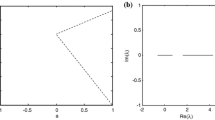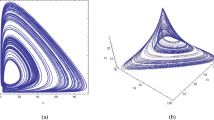Abstract
Reconstructing a pitchfork bifurcation that is destroyed by an exogenous disturbance is important to control it. This paper extends the equivalent-input-disturbance (EID) approach to solve the problem of reconstructing a pitchfork bifurcation when there is an exogenous disturbance for the first time. A nonlinear term and a bifurcation parameter are designed in the system to reconstruct the pitchfork bifurcation. The bifurcation characteristics of the equilibriums of the system are analyzed by exploring the features of the EID-based system. This provides us analytic solutions for a system with a degree higher than four for the first time. Unlike other pitchfork-bifurcation control systems, the EID-based control system only rejects the disturbance and retains the nonlinearity. Numerical examples demonstrate the effectiveness of the presented method and show its superiority over others. The robustness of the reconstruction with respect to measurement noise and control of a pitchfork bifurcation are also shown by the examples.










Similar content being viewed by others
References
Kuznetsov, Y.X.: Elements of Applied Bifurcation Theory. Springer, New York (2013)
Huang, C., Cao, J., Xiao, M., Assaedi, A., Alsaadi, F.E.: Controlling bifurcation in a delayed fractional predator-prey system with incommensurate orders. Appl. Math. Comput. 293, 293–310 (2017)
Xie, Y., Chen, L., Kang, Y.M., Aihara, K.: Controlling the onset of Hopf bifurcation in the Hodgkin-Huxley model. Phys. Rev. E 77, 061921 (2008)
Cai, P., Yuan, Z.Z.: Hopf bifurcation and chaos control in a new chaotic system via hybrid control strategy. Chin. J. Phys. 55, 64–70 (2017)
Chen, G., Moiola, J.L., Wang, H.O.: Bifurcation control: theories, methods, and applications. Int. J. Bifurc. Chaos 10(3), 511–548 (2000)
Abed, E.H., Fu, J.H.: Local feedback stabilization and bifurcation control, II. Stationary bifurcation. Syst. Control Lett. 8(5), 467–473 (1987)
Abed, E.H., Fu, J.H.: Local feedback stabilization and bifurcation control, I. Hopf bifurcation. Syst. Control Lett. 7(1), 11–17 (1986)
Zhang, X., Zhang, Q.: Bifurcation analysis and control of a class of hybrid biological economic models. Nonlinear Anal. Hybrid Syst. 3(4), 578–587 (2009)
Luo, G.W., Lv, X.H.: Controlling bifurcation and chaos of a plastic impact oscillator. Nonlinear Anal. Real World Appl. 10(4), 2047–2061 (2009)
Liu, F., Guan, Z.H., Wang, H.O.: Controlling bifurcations and chaos in TCP-UDP-RED. Nonlinear Anal. Real World Appl. 11(3), 1491–1501 (2011)
Xiao, M., Zheng, W.X., Cao, J.: Bifurcation and control in a neural network with small and large delays. Neural Netw. 44, 132–142 (2013)
Wang, X., Deng, L., Zhang, W.: Hopf bifurcation analysis and amplitude control of the modified Lorenz system. Appl. Math. Comput. 225, 333–344 (2013)
Zhu, L., Zhao, H., Wang, X.: Bifurcation analysis of a delay reaction-diffusion malware propagation model with feedback control. Commun. Nonlinear Sci. Numer. Simul. 22(1–3), 747–768 (2015)
Yin, X., Liu, F., She, J.: Extension theorem of impulsive control and its applications. Acta Autom. Sin. 46(1), 55–64 (2020)
Gazor, M., Sadri, N.: Bifurcation controller designs for the generalized cusp plants of Bogdanov-Takens singularity with an application to ship control. SIAM J. Control Optim. 57(3), 2122–2151 (2019)
Moradi, H., Vossoughi, G.: Multivariable control of the bifurcation and harmonic perturbations to improve the performance of air-handling units. ISA Trans. 60, 119–127 (2016)
Moradi, H., Abbasi, M.H., Moradian, H.: Improving the performance of a nonlinear boiler-turbine unit via bifurcation control of external disturbances: a comparison between sliding mode and feedback linearization control approaches. Nonlinear Dyn. 85(1), 229–243 (2016)
Guo, L., Cao, S.: Anti-disturbance control theory for systems with multiple disturbances: A survey. ISA Transactions. 53(2014), 846–849 (2014)
She, J., Fang, M.X., Ohyama, Y., Kobayashi, H., Wu, M.: Improving disturbance-rejection performance based on an equivalent-input-disturbance approach. IEEE Trans. Ind. Electron. 55(1), 380–389 (2008)
Liu, R., Liu, G., Wu, M., Nie, Z.: Disturbance rejection for time-delay systems based on the equivalent-input-disturbance approach. J. Franklin Inst. 351(6), 3364–3377 (2014)
Liu, R., Liu, G., Wu, M., Xiao, F., She, J.: Robust disturbance rejection based on equivalent-input-disturbance approach. IET Control Theory Appl. 7(9), 1261–1268 (2013)
Yu, P., Wu, M., She, J., Liu, K., Nakanishi, Y.: Robust tracking and disturbance rejection for linear uncertain system with unknown state delay and disturbance. IEEE/ASME Trans. Mechatron. 23(3), 1445–1455 (2018)
Ding, M., She, J., Yokoyama, R., Wu, M., Cao, W.: Two-loop power-flow control of grid-connected microgrid based on equivalent-input-disturbance approach. IEEJ Trans. Electr. Electron. Eng. 10(1), 36–43 (2015)
Miyamoto, K., She, J., Imani, J., Xin, X., Sato, D.: Equivalent-input-disturbance approach to active structural control for seismically excited buildings. Eng. Struct. 125, 392–399 (2016)
Cai, W., She, J., Wu, M., Ohyama, Y.: Disturbance suppression for quadrotor UAV using sliding-mode-observer-based equivalent-input-disturbance approach. ISA Trans. 92, 86–297 (2019)
Cai, W., She, J., Wu, M., Ohyama, Y.: Quadrotor waypoint-tracking control under exogenous disturbances based on equivalent-input-disturbance approach. J. Franklin Inst. 357(8), 4709–4741 (2020)
Zhang, A., Lai, X., Wu, M., She, J.: Nonlinear stabilizing control for a class of underactuated mechanical systems with multi degree of freedoms. Nonlinear Dyn. 89, 2241–2253 (2017)
Ohishi, K., Nakao, M., Ohnishi, K., Miyachi, K.: Microprocessor-controlled dc motor for load-insensitive position servo system. IEEE Trans. Ind. Electron. 34(1), 44–49 (1987)
Han, J.: From PID to active disturbance rejection control. IEEE Trans. Ind. Electron. 56(3), 900–906 (2009)
Chen, W., Yang, J., Guo, L., Li, S.: Disturbance-observer-based control and related methods: an overview. IEEE Trans. Ind. Electron. 632, 1083–1095 (2016)
Yin, X., She, J., Wu, M., Sato, D., Hirota, K.: Disturbance rejection and performance analysis for nonlinear systems based on nonlinear equivalent-input-disturbance approach. Nonlinear Dyn. 100, 3497–3511 (2020)
Fan, S.: A new extracting formula and a new distinguishing means on the one variable cubic equation. Nat. Sci. J. Hainan Teach. College 2(2), 91–98 (1989)
Gao, F., Wu, M., She, J., Cao, W.: Disturbance rejection in nonlinear systems based on equivalent-input-disturbance approach. Appl. Math. Comput. 282, 244–253 (2016)
Wang, O.H., Abed, E.H.: Bifurcation control of a chaotic system. Automatica 31(9), 1213–1226 (1995)
Khalil, H.K.: Nonlinear Systems, 3rd edn. Prentice-Hall, Upper Saddle River (2002)
Ermentrout, B.: Simulating, Analyzing, and Animating Dynamical Systems: A Guide to XPPAUT for Researchers and Students. SIAM, Philadelphia (2002)
Rajapakse, I., Smale, S.: The pitchfork bifurcation. Int. J. Bifurc. Chaos 27(09), 1750132 (2017)
Acknowledgements
This work was supported in part by the National Key R&D Program of China under Grant 2017YFB1300900; the National Natural Science Foundation of China under Grant 61873348; the Natural Science Foundation of Hubei Province, China, under Grant 2020CFA031; Wuhan Applied Foundational Frontier Project under Grant 2020010601012175; and the 111 Project under Grant B17040.
Author information
Authors and Affiliations
Corresponding author
Ethics declarations
Conflict of interest
The authors declare that they have no conflict of interest regarding the publication of this paper.
Additional information
Publisher's Note
Springer Nature remains neutral with regard to jurisdictional claims in published maps and institutional affiliations.
Appendix
Appendix
Convergence of the stable equilibrium in Fig. 1 for \(\lambda =\pm 1.5\) is analyzed below.
We first analyze the convergence of the stable equilibrium for
Substituting (A.1) in (1) yields
Solving
obtains the equilibriums
For
the Jacobian matrix is
Thus, \(x_o=0\) is an unstable equilibrium. For
the Jacobian matrix is
Thus, \(x_o=~\pm \sqrt{1.5}\) are stable equilibriums. To analyze the convergence of the stable equilibrium, we have to make a coordinate transformation. Let
Substituting (A.9) in (A.2) yields
where
The stable equilibrium \(x_o=\sqrt{1.5}\) for (A.2) is transformed to the stable equilibrium \(z_o=0\) for (A.10).
Since
is Hurwitz, for any positive definite symmetric matrix \(Q_N\), the solution, \(P_N\), of
is positive definite. Let
be a Lyapunov function candidate of (A.10). The derivative of \(V_N(z)\) along the trajectories of (A.10) is given by
The first term on the right side of (A.12) is negative definite, while the second term is indefinite. Since the function \(f_z(z)\) satisfies
Therefore, for any \(\gamma >0\), there exists \(\nu >0\) such that
Hence,
However,
Note that \(\delta _{\min }(Q_N)\) is real and positive because \(Q_N\) is symmetric and positive definite. Thus,
Choosing
ensures that \(\mathrm{d}{V}_N(z)/\mathrm{d}t\) is negative definite. Thus, \(z_o=0\) is asymptotically stable, which means that for \(z(0)<\nu \), z(t) converges to 0 as \(t\rightarrow \infty \).
The proof for \(x_o=-\sqrt{1.5}\) is the same as that for \(x_o=\sqrt{1.5}\). Thus, it is omitted.
Next, we analyze the convergence of the stable equilibrium for
Substituting (A.14) in (1) yields
where
Solving
obtains the equilibrium
For (A.17),
Thus, \(x_o=0\) is a stable equilibrium.
Since
is Hurwitz, for any positive definite symmetric matrix \(Q_M\), the solution, \(P_M\), of
is positive definite. Let
be a Lyapunov function candidate of (A.15). The derivative of \(V_M(x)\) along the trajectories of (A.15) is given by
The first term on the right side of (A.19) is negative definite, while the second term is indefinite. Since the function \(f_x(x)\) satisfies
which is the same as (A.13), the convergence analysis of \(x_o=0\) for \(\lambda =-1.5\) is the same as that of \(x_o=\sqrt{1.5}\) for \(\lambda =1.5\), thus is omitted.
Rights and permissions
About this article
Cite this article
She, J., Yin, X., Wu, M. et al. Reconstruction of pitchfork bifurcation with exogenous disturbances based on equivalent-input-disturbance approach. Nonlinear Dyn 102, 2699–2709 (2020). https://doi.org/10.1007/s11071-020-06066-8
Received:
Accepted:
Published:
Issue Date:
DOI: https://doi.org/10.1007/s11071-020-06066-8




